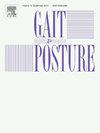Impact of amputation level on gait disorders in transfemoral and transtibial amputees
IF 2.2
3区 医学
Q3 NEUROSCIENCES
引用次数: 0
Abstract
Question
How does the level of lower limb amputation affect spatiotemporal gait asymmetry and cautious gait criteria to inform tailored rehabilitation interventions?
Design
A retrospective study analyzing gait patterns in individuals with unilateral lower limb amputations.
Participants
49 amputees (22 (45 %) transtibial, 27 (55 %) transfemoral) compared to 30 healthy controls, evaluated between January 2018 and June 2023.
Intervention Participants
performed a spontaneous walking speed test on a pressure mat (Zebris® FDM 2 & 3 System, 100 Hz, v 1.18.44, GmbH, Isny, Germany) after completing rehabilitation.
Outcome Measures
Gait symmetry and cautious gait were assessed using spatio-temporal parameters, center of pressure (CoP) displacement, and foot segment forces.
Results
Increased asymmetry was observed in stance phase duration, step length, stance duration, and walking speed (95 % CI 0.398–0.658) depending on the level of amputation. Transfemoral amputees showed significant increases in step width (95 % CI 0.201–0.512), double support phase (95 % CI 0.000–0.150), and medio-lateral CoP displacement (95 % CI 0.039–0.326). The increased asymmetry in spatio-temporal parameters suggests different compensation strategies between transfemoral and transtibial levels. These differences highlight the importance of the rehabilitation paradigm in managing asymmetry and its underlying compensations during locomotor activities.
Conclusion
The level of amputation significantly impacts gait asymmetry and cautious gait parameters. Transfemoral amputees exhibit more pronounced cautious gait characteristics, likely due to the need for greater stabilization. These findings underscore the importance of personalized rehabilitation to address specific compensations and gait abnormalities based on amputation level.
求助全文
约1分钟内获得全文
求助全文
来源期刊

Gait & posture
医学-神经科学
CiteScore
4.70
自引率
12.50%
发文量
616
审稿时长
6 months
期刊介绍:
Gait & Posture is a vehicle for the publication of up-to-date basic and clinical research on all aspects of locomotion and balance.
The topics covered include: Techniques for the measurement of gait and posture, and the standardization of results presentation; Studies of normal and pathological gait; Treatment of gait and postural abnormalities; Biomechanical and theoretical approaches to gait and posture; Mathematical models of joint and muscle mechanics; Neurological and musculoskeletal function in gait and posture; The evolution of upright posture and bipedal locomotion; Adaptations of carrying loads, walking on uneven surfaces, climbing stairs etc; spinal biomechanics only if they are directly related to gait and/or posture and are of general interest to our readers; The effect of aging and development on gait and posture; Psychological and cultural aspects of gait; Patient education.
 求助内容:
求助内容: 应助结果提醒方式:
应助结果提醒方式:


